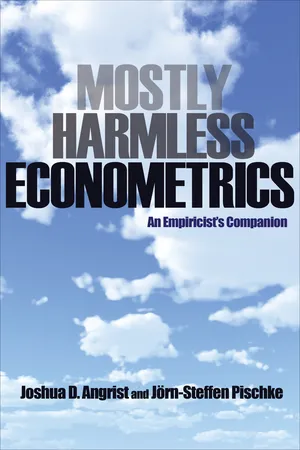![]()
Part II
The Core
![]()
Chapter 3
Making Regression Make Sense
“Let us think the unthinkable, let us do the undoable. Let us prepare to grapple with the ineffable itself, and see if we may not eff it after all.”
Douglas Adams, Dirk Gently’s Holistic Detective Agency
Angrist recounts:
I ran my first regression in the summer of 1979 between my freshman and sophomore years as a student at Oberlin College. I was working as a research assistant for Allan Meltzer and Scott Richard, faculty members at Carnegie-Mellon University, near my house in Pittsburgh. I was still mostly interested in a career in special education, and had planned to go back to work as an orderly in a state mental hospital, my previous summer job. But Econ 101 had got me thinking, and I could also see that at the same wage rate, a research assistant’s hours and working conditions were better than those of a hospital orderly. My research assistant duties included data collection and regression analysis, though I did not understand regression or even statistics at the time.
The paper I was working on that summer (Meltzer and Richard, 1983) is an attempt to link the size of governments in democracies, measured as government expenditure over GDP, to income inequality. Most income distributions have a long right tail, which means that average income tends to be way above the median. When inequality grows, more voters find themselves with below-average incomes. Annoyed by this, those with incomes between the median and the average may join those with incomes below the median in voting for fiscal policies that take from the rich and give to the poor. The size of government consequently increases.
I absorbed the basic theory behind the Meltzer and Richard project, though I didn’t find it all that plausible, since voter turnout is low for the poor. I also remember arguing with my bosses over whether government expenditure on education should be classified as a public good (something that benefits everyone in society as well as those directly affected) or a private good publicly supplied, and therefore a form of redistribution like welfare. You might say this project marked the beginning of my interest in the social returns to education, a topic I went back to with more enthusiasm and understanding in Acemoglu and Angrist (2000).
Today, I understand the Meltzer and Richard study as an attempt to use regression to uncover and quantify an interesting causal relation. At the time, however, I was purely a regression mechanic. Sometimes I found the RA work depressing. Days would go by when I didn’t talk to anybody but my bosses and the occasional Carnegie-Mellon Ph.D. student, most of whom spoke little English anyway. The best part of the job was lunch with Allan Meltzer, a distinguished scholar and a patient and good-natured supervisor, who was happy to chat while we ate the contents of our brown bags (this did not take long, as Allan ate little and I ate fast). Once I asked Allan whether he found it satisfying to spend his days perusing regression output, which then came on reams of double-wide green-bar paper. Meltzer laughed and said there was nothing he would rather be doing.
Now we too spend our days happily perusing regression output, in the manner of our teachers and advisers in college and graduate school. This chapter explains why.
3.1 Regression Fundamentals
The end of the previous chapter introduced regression models as a computational device for the estimation of treatment-control differences in an experiment, with and without covariates. Because the regressor of interest in the class size study discussed in section 2.3 was randomly assigned, the resulting estimates have a causal interpretation. In most studies, however, regression is used with observational data. Without the benefit of random assignment, regression estimates may or may not have a causal interpretation. We return to the central question of what makes a regression causal later in this chapter.
Setting aside the relatively abstract causality problem for the moment, we start with the mechanical properties of regression estimates. These are universal features of the population regression vector and its sample analog that have nothing to do with a researcher’s interpretation of his output. These properties include the intimate connection between the population regression function and the conditional expectation function and the sampling distribution of regression estimates.
3.1.1 Economic Relationships and the Conditional Expectation Function
Empirical economic research in our field of labor economics is typically concerned with the statistical analysis of individual economic circumstances, and especially differences between people that might account for differences in their economic fortunes. Differences in economic fortune are notoriously hard to explain; they are, in a word, random. As applied econometricians, however, we believe we can summarize and interpret randomness in a useful way. An example of “systematic randomness” mentioned in the introduction is the connection between education and earnings. On average, people with more schooling earn more than people with less schooling. The connection between schooling and earnings has considerable predictive power, in spite of the enormous variation in individual circumstances that sometimes clouds this fact. Of course, the fact that more educated people tend to earn more than less educated people does not mean that schooling c...

